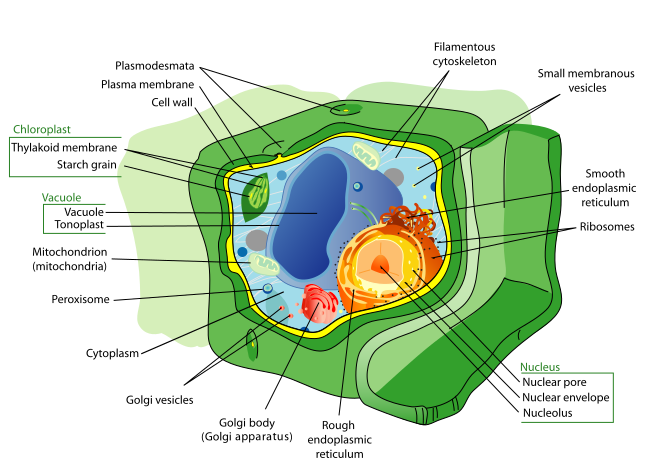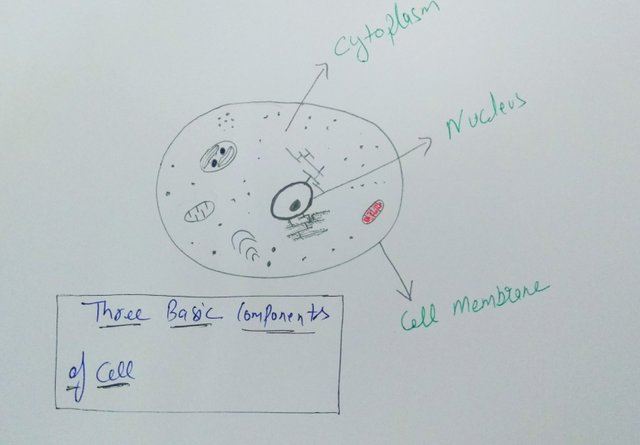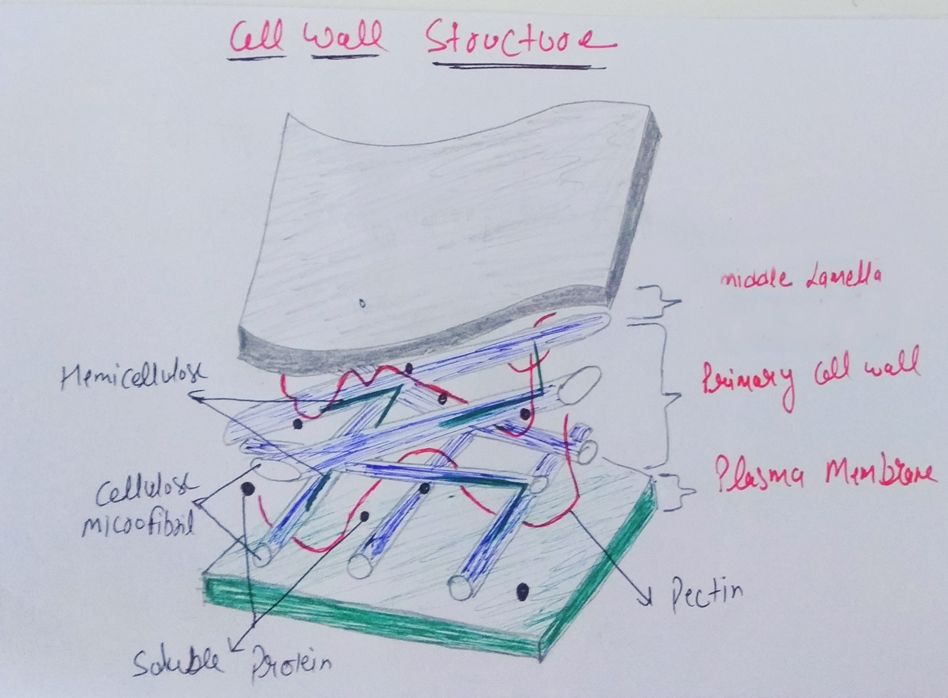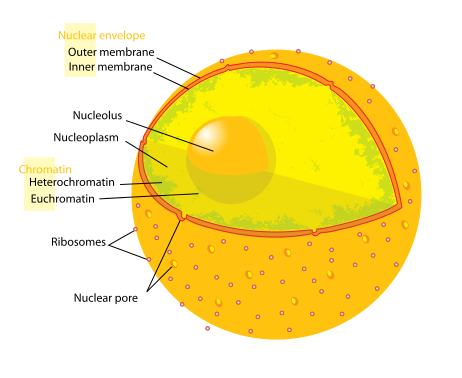#1 Cell Structure and Functions
Cell Structure and Functions
The cell (Latin word means ‘little room’) is the basic structural, functional and biological unit of all known living organisms. Cells may be compared to the bricks which are assembled to make a building. Cells are also assembled to make the body of every organism. The study of cells is called cell biology.

commons.wikimedia.org, by LadyofHats, CC0
Shape and Size of cells
Cells can be of different shape and size. It can be different for different organisms and may also vary from the cell of one organ to another organ in the same organism.
Generally, cells are round, spherical or elongated in shape but some cells are long and pointed at both ends (a spindle shape) whereas, some are quite long. The shape and size of cell are related to the specific functions that they perform. In some cases, the cell shaped could be more or less fixed and peculiar for a particular type of cell, e.g., nerve cells have a typical shape.
Note:
- Most of the cells are microscopic in size and are not visible to unaided eye.
- The smallest cell is 0.1 to 0.5 micrometre in bacteria. i.e., Mycoplasma Genitalium
- The largest cell measuring 170mm*130mm, is the egg of an ostrich.
Number of cells in Living Organisms
All organisms are composed of cells. Some cells, which can exist as an independent organism are called unicellular organism or single-celled organisms, e.g., Amoeba, Chlamydomonas, Paramecium, and bacteria, whereas multicellular organisms are those that consist of more than one cell., e.g., fungi, plants, and animals. Every multicellular organism has come from a single cell. Cells also divide to produce cells o their own kind and their functions are performed by different organs, e.g., blood cell, nerve cell, fat cell, sperm, bone cell, ovum, smooth muscle cell, etc.
Characteristics of cells
They contain hereditary information which passes from one generation to another.
Cells are capable of independent existence and they have the ability to replicate independently.
Number of cells present depends on the size of an organ or body organization.
Each living cell has the capacity to perform certain basic functions depending upon its location.
They are lesser in number in small organisms and large animals like beer, whale, etc have greater number of cells.
Cell Theory
Cell theory as described today is as follows
(i) All organisms are composed of one or more cells.
(ii) Cell is the most basic unit of structure, function, and organisation in all organisms.
(iii) All cells arise from pre-existing living cells.
Viruses do not follow cell theory.
Cell Structure

Structurally, the cell constitutes the following three basic components
(i) Cell membrane or plasma membrane
(ii) Nucleus
(iii) Cytoplasm
All these components interact with its environment to perform various functions.
Cell Wall
The cell wall is a rigid (non-living) but flexible covering of the cell which is located outside the cell membrane and provides shape and structural support to the cells. It also protects the cells from the outside attack and infection. Cell walls are particularly found in plants, fungi, bacteria, algae and some archaea. Animals and protozoans do not have cell walls.
Cell walls are made up of various materials depending on the species like
Bacterial cell wall is made up of peptidoglycan.
Fungi's cell wall is made up of the glucosamine polymer chitin.
Algae's cell wall is made up of glycoproteins and polysaccharides.
Plant's cell wall is mainly made up of cellulose, which provides structural strength to it.
Structure of Cell Wall

Three Basic Layers of Cell Wall
Outermost Layer
Also called middle lamella, rich in pectins, forms interface A between adjacent plant cells and glue them together.
Secondary Cell Wall
Thick layer, forms when cell is fully grown, not found in all cells, it is 2-3 cell thick.
Primary Cell Wall
Thin flexible layer, forms when the cells grow, it is single layered.
Functions of Cell Wall
(i) Cell wall permits the cell of plants, fungi and bacteria to withstand without bursting by acting as a pressure vessel.
(ii) It also helps cell to tolerate much greater changes in the surrounding medium as compared to animal cells.
Cell Membrane or Plasma Membrane
This is the outermost covering of cell, separating the contents of the cell from its external environment. Plasma membrane is made up of lipids (major content is phospholipid) and proteins. , Structurally, it is a thin, flexible and semi-permeable or selectively permeable membrane. The cytoplasm and nucleus are enclosed within the cell membrane. Animal cells, plant cells, prokaryotic cells and fungal cells all have cell membranes as their outer covering except viruses which are devoid of cell membrane.
Functions of Cell Membrane
(i) Its major function is to maintain shape of the cell by providing support to it.
(ii) It protects the interior components of the cell by selectively allowing the movement of certain substances (ions, organic molecules) in and out of the cell. This function is regulated by selectively permeable nature of the membranes.
(iii) The flexible nature of the cell membrane allows the cell to engulf food and other substances from the surrounding environment and this process of intake is known as endocytosis, e.g., in Amoeba.
(iv) It also serves as a base for the attachment of cytoskeleton in some organisms and the cell wall in others.
(v) It performs various other functions in a cell and cell signaling. such as cell adhesion, ion conductivity, and cell signaling
Nucleus
Nucleus was discovered by Robert Brown. It is an important component of the cell. It is generally spherical or elliptical in shape and is located in the centre of the cell. It acts as a major controlling center of the cell and also called as brain of the cell.
Various components of nucleus are as follows
(1) Nuclear Membrane
Nucleus is separated from the cytoplasm by a membrane, called nuclear membrane. It is a double-layered structure made up of protein and fat which encloses the contents of the nucleus. A fluid-filled space or perinuclear space is present between the two layers of a nuclear membrane. The nuclear membrane contains micropores, allowing the transfer of material from inside the nucleus to outside (to the cytoplasm). The outer layer of the nuclear membrane is connected through the endoplasmic reticulum of the cell.
Note:
Organisms, whose cells lack a nuclear membrane, are called prokaryotes (pro = primitive or primary; karyote = nucleus) and organisms with cells having a nuclear membrane, are called eukaryotes (eu= true; karyote = nucleus).
All organisms other than bacteria and blue green algae are called eukaryotes.
(2) Nucleoplasm
As compared to the protoplasm inside the cell, nucleoplasm is the protoplasm present inside the nucleus of the cell. It is little acidic and also known as karyoplasm or nuclear sap. It is composed of nucleolus and chromatin. It is made up of abundant protein, phosphorus, and nucleic acid.
(3) Nucleolus
The nucleoli are spherical structures present in the nucleoplasm. The content of nucleolus is continuous with the rest of the nucleoplasm as it is not a membrane bound structure. There are generally one or more spherical nucleoli inside the nucleus of the cell, but some eukaryotic organisms have a nucleus that contains upto four or more nucleoli.
The main function of the nucleolus is to synthesize rRNA and to store genetic information in its DNA.
Nuclear Matrix
It is a network of fine fibrils of acid proteins that function as scaffold for chromatin The chromatin is a hereditary DNA protein fibrillar complex which is named so because of its ability to get stained with certain dyes. It is basically composed of histones (a type of protein in DNA and RNA). DNA in chromatin is mainly responsible for genetic characters in an organism
(2) Chromosomes
During the cell division, chromatin shrinks (compressed) and gets divided into various smaller, thick and consolidated form, known as chromosomes. These are thread-like, rod-shaped structures and are made up of a combination of DNA (Deoxyribonucleic Acid) and protein, found in the nuclei of cells.
Chromosomes consist of a thick jelly like substance, called matrix and chromonemata (two mutually thin interconnected coil shaped structure). As every chromonemata is called chromatid hence, every chromosome is composed of two chromatids. They also carry genes that act as a unit of inheritance in living organisms.
Genes control the transfer of characters from the parents to next generation. Thus, chromosomes are also called hereditary vehicles in an organis
The cell is the smallest functional unit of life and it can exist independently. It’s various organelles and structures are essential for the processes it undergoes. Every organelle plays a vital role in maintenance of cell morphology as well as carrying out certain cellular functions. We were able to look at the eukaryotic and prokaryotic cells as well as the cell theory and also highlight the features and functions of various organelles in the cell. We also able to topic in this article: The shape and size, characteristics of cell, cell theory, as well as two common cellular structures; 1) cell membrane 2) nucleus. See you on the next part of this post and I hope you did have a good read
Thanks for reading!
Cell
Cell theory
Cell Structure
Cell membrane
Cell nucleus
Image Sources
1st and 4th images are from wikicommons licensed under creative commons and eligible for commercial use.
I'm a proud member of the steemstem community which promotes quality posts in the science, technology, engineering and mathematics fields on the steem blockchain mainly through interaction and engagement. Feel free to join us on discord

Amazing work, I remember the time when I was reading about it for the first time, in school, I was around 10 or 11. It felt unreal and I was happy to learn about it. Do you follow any school in this field or you are just passioned?
You seem to have learned a lot in a short time, I will follow you around in your explorations here :P
Thanks, @alexdory for like my work. I never interested to learn these things when I was a child but now my interest in books increasing day by day. I love to read all kind of books.
You just planted 0.38 tree(s)!
Thanks to @kamesh
We have planted already 5985.48 trees
out of 1,000,000
Let's save and restore Abongphen Highland Forest
in Cameroonian village Kedjom-Keku!
Plant trees with @treeplanter and get paid for it!
My Steem Power = 18695.83
Thanks a lot!
@martin.mikes coordinator of @kedjom-keku
I was never good in the physical sciences ! My diagrams and practicals helped me always.
All I remember is - "Cells Are The Building Blocks" :) ...
Thank you for your informative post, @kamesh :)
I was also not good in science expect mathematics but now I am reading again and you know. This time I find that these subjects are really interesting.
😁😃
😊😊 that's great 😊
Wow! Really hard worked ! It's true never had such interest in reading while we were in schools. But it seems more curosity to know about more now.
Thanks. I am happy that you like it.
Its so sweet of you! Thanks!
Youve made a nice post man. I enjoyed every bit of this :)
Well written @kamesh . Your post gives a good idea about cells even to those who have never heard about this before. Have a good day!
Yes @sathyasankar even I am not student of science but I love to read science everyday. Even I am getting science knowledge everyday. Thanks
You got a 4.43% upvote from @emperorofnaps courtesy of @kamesh!
Want to promote your posts too? Send 0.05+ SBD or STEEM to @emperorofnaps to receive a share of a full upvote every 2.4 hours...Then go relax and take a nap!
Thanks Dude for your kind words. 😁
You have been defended with a 10.99% upvote!
I was summoned by @kamesh.
You got a 28.69% upvote from @redlambo courtesy of @kamesh! Make sure to use tag #redlambo to be considered for the curation post!